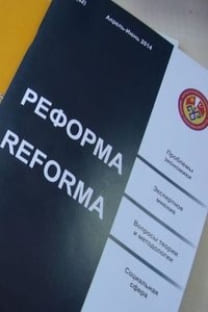The Integration Potential of Central Asia in Light of the Rise of the Turkic World
In this article, the author reflects on the potential for integrating Central Asian states in the context of developing the "Turkic World" and cooperating with Turkic-speaking countries. The author notes the "artificiality" of the discourse on the vulnerability to the challenges of time and the fragmentation of the Central Asian region, fueled by the still weakly expressed processes of regionalization. At the same time, he argues for the sustainability of the state and for a positive future for the countries of Central Asia. In his analysis, the author identifies a number of factors as fundamental prerequisites - unifying principles for the future integration of Central Asian states. These include the exchange of resources, region history common grounds, the unity of the linguistic base of national languages; the same religion; challenges to regional security. The author attaches great importance to the active development of the "Turkic world" and is of the opinion that in view of the rapprochement of Turkic-speaking countries within the Organization of Turkic States (OTS). The integration of the Central Asian region should not fade into the background. On the contrary, the potential of OTS expected to used in the further development of regional cooperation.
Anahtar Kelimeler:
Central Asia, regionalization, integration, potential, Turkic World
The Integration Potential of Central Asia in Light of the Rise of the Turkic World
In this article, the author reflects on the potential for integrating Central Asian states in the context of developing the "Turkic World" and cooperating with Turkic-speaking countries. The author notes the "artificiality" of the discourse on the vulnerability to the challenges of time and the fragmentation of the Central Asian region, fueled by the still weakly expressed processes of regionalization. At the same time, he argues for the sustainability of the state and for a positive future for the countries of Central Asia. In his analysis, the author identifies a number of factors as fundamental prerequisites - unifying principles for the future integration of Central Asian states. These include the exchange of resources, region history common grounds, the unity of the linguistic base of national languages; the same religion; challenges to regional security. The author attaches great importance to the active development of the "Turkic world" and is of the opinion that in view of the rapprochement of Turkic-speaking countries within the Organization of Turkic States (OTS). The integration of the Central Asian region should not fade into the background. On the contrary, the potential of OTS expected to used in the further development of regional cooperation.
Keywords:
Central Asia regionalization, integration, potential, Turkic World, geopolitics,
___
- Атжанова, Д. (2022). «Буферные зоны: зачем Украина, Казахстан и Кавказ нужны России?». – URL: https://the- steppe.com/razvitie/bufernye-zony-zachem-ukraina-kazahstan-i-kavkaz-nuzhny-rossii
- Бжезинский, З. (1998). «Великая шахматная доска (Господство Америки и его геостратегические императивы)». Глава 5. «Евразийские Балканы». Москва: Междунар. отношения, с. 65-70.
- Данков, А. (2013). «Центральная Азия в 2025 году: от неопределенности к кризису». Вестник Томского государственного университета. Сер. «История». № 1(21), с. 118-124.
- Хербст, Дж. Э. (2017). «Американский интерес в Центральной Азии будет усилен». – URL: https://eadaily.com/ru/news/2017/11/14/dzhon-edvard-herbst-amerikanskiy-interes-v-centralnoy-azii-budet-usilen;
- Казанцев, А. (2013). «Пять сценариев будущих границ Центральной Азии». – URL: https://russiancouncil.ru/analytics-and-comments/analytics/pyat-stsenariev-budushchikh-granits-tsentralnoy-azii/
- Как достичь синергетического эффекта в Центральной Азии? (2019). Обзор мнений экспертов. URL:https://www.caa-network.org/archives/17309
- Мусаев, А.И. (2003). «Түрк тилүү элдердин адабияты». Бишкек, 80 б.
- Сатпаев, Д. (2013). «Пороховая бочка Центральной Азии». – URL: https://forbes.kz/process/porohovaya_bochka_tsentralnoy_azii/
- Самаркандский прием. (2022). Общенациональная газета «Слово Кыргызстана», 15 ноября, №118 (24230).
- Толипов, Ф. (2015). «НАРБК-геополитика в Центральной Азии». – URL: https://cabar.asia/ru/cabar-asia-narbk-geopolitika-v-tsentralnoj-azii
- Хантингтон, С. (2017). «Столкновение цивилизаций». [Пер. с англ. Т. Велимеева]. Москва: Издательство АСТ, 640 с. Центральная Азия 2027: меняющийся стратегический ландшафт. Вероятные сценарии на 10 лет вперед. (2017). – URL: https://library.fes.de/pdf-files/bueros/kasachstan/13872.pdf
- Центральная Азия и внешние державы. (2019). Журнал «PRO et CONTRA» (ЗА и ПРОТИВ). № 1-2 (58). – URL: https://carnegieendowment.org/files/ProEtContra_58_all.pdf
- Школьников, А. (2022). «Геостратегический взгляд на будущее Средней Азии». – URL: https://shkolnikov.info/articles/11-analitika-i-prognozy/106423-geostrategicheskiy-vzgljad-na-budushhee-sredney-aziihttps://shkolnikov.info/articles/11-analitika-i-prognozy/106423-geostrategicheskiy-vzgljad-na-budushhee-sredney-azii
- Turkic World Vision – 2040. (2021) – URL: https://www.turkicstates.org/assets/pdf/haberler/turkic-world-vision-2040-2396-97.pdf
- Samarkand declaration of the ninth summit of the Organization of Turkic States. (2022). – URL:https://turkicstates.org/assets/pdf/haberler/samarkand-declaration-2679-165.pdf
- ISSN: 1694-5158
- Yayın Aralığı: Yılda 2 Sayı
- Başlangıç: 1999
- Yayıncı: Kırgızistan Türkiye Manas Üniversitesi
Sayıdaki Diğer Makaleler
"YEŞİL FİNANS" KATEGORİSİNİN TEORİK VE METODOLOJİK TEMELLERİ
Damira BEKTENOVA, Meerim KURMANBEKOVA
Almaz BAKETAEV, Akylbek ARSTANBEK UULU, Malik-aidar ABAKİROV, Abdil TASHİROV
The Integration Potential of Central Asia in Light of the Rise of the Turkic World
Kırgızistan'da turizm: salgın ve sonuçları
ORTA ASYA'DAKİ KADINLAR: WEB OF SCIENCE VERİTABANI MATERYALLERİNE İLİŞKİN LİTERATÜR TARAMASI
